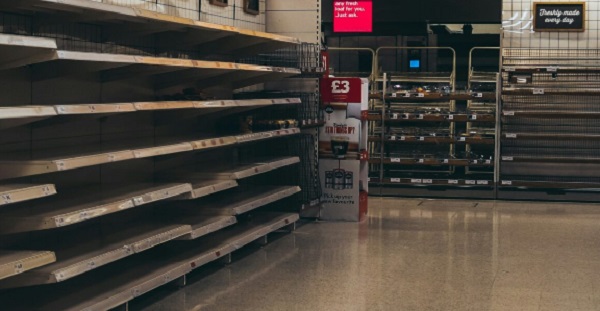Canadian Energy Centre
Unleashing Canada’s competitive advantage in energy and natural resources

From the Canadian Energy Centre
By Cody Ciona
Q&A with Bryan Detchou, senior director of natural resources, environment and sustainability with the Canadian Chamber of Commerce
Canada’s energy sector is one of the country’s greatest strengths, says an emerging leader with the Canadian Chamber of Commerce.
Bryan Detchou is the Chamber’s senior director of natural resources, environment and sustainability.
A former government relations consultant and staffer on Parliament Hill, in 2023 The Peak recognized Detchou as one of Canada’s young leaders shaping the country’s economy, culture and society.
The Chamber boasts a membership of over 200,000 businesses, including many energy-related companies. Detchou helps advocate for achieving the sector’s untapped potential.
Here’s what he shared with the Canadian Energy Centre:
CEC: Why does the Canadian Chamber of Commerce support Canada’s oil and natural gas sector?
BD: The mandate of the Canadian Chamber of Commerce is to support and be the leading voice for all businesses across the Canadian economy.
You cannot discuss the Canadian economy without recognizing the essential role of the oil and gas sector.
CEC: What role should Canada’s energy sector play in the 21st century Canadian and world economies?
BD: We believe that Canada’s energy and natural resources sectors are sources of pride and deserve strong support. These sectors hold the potential for Canada to exceed expectations on the global stage, positioning us as a key player in solving many of the world’s pressing challenges.
The conflict in Ukraine has exposed vulnerabilities in European and global energy security, underscoring the critical role Canada can play in addressing these issues. It is not only Canada’s responsibility to its citizens but also its duty to the global community to be a strong and reliable energy partner.
However, our failure to act decisively on energy security weakens our position and undermines our ability to contribute meaningfully to the reduction of global emissions.
CEC: How can Canadian energy businesses take a leadership position in emissions reduction?
BD: The majority of emissions reductions are being driven by the private sector, and we’re already seeing significant investments from various organizations. However, the challenge lies in the substantial capital required for these initiatives.
Before making major investment decisions, companies need a level of certainty and predictability in the markets they operate in—this is where the government can play a stronger role.
Regulatory hurdles, such as amendments to the Impact Assessment Act and the slow deployment of Investment Tax Credits, continue to create uncertainty.
We must understand that this is a global race. Canada is not the only country working to reduce greenhouse gas emissions and attract the necessary investment.
It is our responsibility to identify and leverage our competitive advantages. There is still much Canada can do to ensure its regulatory framework is conducive to attracting investment and driving environmental progress.
CEC: How is the federal greenwashing Bill C-59 impacting Canadian energy companies?
BD: From the outset, we have been fully engaged in addressing the challenges posed by this new legislation, starting with our involvement when the amendment was first introduced in the House of Commons committee in late May.
We testified before the Senate in early June, voicing the concerns of the industry, and have remained actively engaged ever since.
We unequivocally support the goal of ensuring that no Canadian company engages in deceptive marketing, whether in terms of product claims or the communication of their environmental commitments, particularly those aimed at combating climate change. Transparency and accountability are fundamental.
However, the law’s vague language and the absence of a clearly defined methodology have unfortunately created uncertainty across all sectors of the Canadian economy. This uncertainty hinders the ability of businesses to openly and confidently contribute to Canada’s ambitious climate goals.
Rather than driving environmental progress, the new law has inadvertently undermined the significant efforts already made by Canadian corporations, and by extension, the Canadian government. It has become a barrier to both innovation and meaningful environmental action.
The time has come for the government to revisit this legislation. The government should do now what it should have done in May and work collaboratively with industry stakeholders to develop a made-in-Canada regime that ensures corporate accountability and transparency while fostering, not stifling, innovation and environmental ambition.
Only by doing this can we achieve the climate objectives that Canada is striving for.
CEC: What does the Chamber believe are the best steps forward for Canada’s energy sector?
BD: The best way forward for Canada’s energy sector involves recognizing and leveraging our natural resources as one of the country’s greatest strengths, rather than a weakness. In the face of global challenges Canada’s energy sector must evolve to address these pressing issues.
We advocate for a balanced approach that includes diversifying the energy portfolio with investments in renewable technologies and innovations like carbon capture and storage and hydrogen, ensuring a clear and efficient regulatory framework to attract investment, and strengthening Indigenous partnerships to foster shared prosperity.
Promoting sustainable resource development to meet net-zero targets, expanding global market opportunities, and enhancing collaboration between government and industry are crucial.
By embracing our energy sector as a key asset, Canada can enhance its role on the global stage, support our allies, and combat climate change effectively. Unleashing the full potential of Canada’s natural resources is essential for securing energy security, achieving economic growth and driving long-term prosperity.
Alberta
Alberta’s huge oil sands reserves dwarf U.S. shale

From the Canadian Energy Centre
By Will Gibson
Oil sands could maintain current production rates for more than 140 years
Investor interest in Canadian oil producers, primarily in the Alberta oil sands, has picked up, and not only because of expanded export capacity from the Trans Mountain pipeline.
Enverus Intelligence Research says the real draw — and a major factor behind oil sands equities outperforming U.S. peers by about 40 per cent since January 2024 — is the resource Trans Mountain helps unlock.
Alberta’s oil sands contain 167 billion barrels of reserves, nearly four times the volume in the United States.
Today’s oil sands operators hold more than twice the available high-quality resources compared to U.S. shale producers, Enverus reports.
“It’s a huge number — 167 billion barrels — when Alberta only produces about three million barrels a day right now,” said Mike Verney, executive vice-president at McDaniel & Associates, which earlier this year updated the province’s oil and gas reserves on behalf of the Alberta Energy Regulator.
Already fourth in the world, the assessment found Alberta’s oil reserves increased by seven billion barrels.
Verney said the rise in reserves despite record production is in part a result of improved processes and technology.
“Oil sands companies can produce for decades at the same economic threshold as they do today. That’s a great place to be,” said Michael Berger, a senior analyst with Enverus.
BMO Capital Markets estimates that Alberta’s oil sands reserves could maintain current production rates for more than 140 years.
The long-term picture looks different south of the border.
The U.S. Energy Information Administration projects that American production will peak before 2030 and enter a long period of decline.
Having a lasting stable source of supply is important as world oil demand is expected to remain strong for decades to come.
This is particularly true in Asia, the target market for oil exports off Canada’s West Coast.
The International Energy Agency (IEA) projects oil demand in the Asia-Pacific region will go from 35 million barrels per day in 2024 to 41 million barrels per day in 2050.
The growing appeal of Alberta oil in Asian markets shows up not only in expanded Trans Mountain shipments, but also in Canadian crude being “re-exported” from U.S. Gulf Coast terminals.
According to RBN Energy, Asian buyers – primarily in China – are now the main non-U.S. buyers from Trans Mountain, while India dominates purchases of re-exports from the U.S. Gulf Coast. .
BMO said the oil sands offers advantages both in steady supply and lower overall environmental impacts.
“Not only is the resulting stability ideally suited to backfill anticipated declines in world oil supply, but the long-term physical footprint may also be meaningfully lower given large-scale concentrated emissions, high water recycling rates and low well declines,” BMO analysts said.
Alberta
The case for expanding Canada’s energy exports

From the Canadian Energy Centre
For Canada, the path to a stronger economy — and stronger global influence — runs through energy.
That’s the view of David Detomasi, a professor at the Smith School of Business at Queen’s University.
Detomasi, author of Profits and Power: Navigating the Politics and Geopolitics of Oil, argues that there is a moral case for developing Canada’s energy, both for Canadians and the world.
CEC: What does being an energy superpower mean to you?
DD: It means Canada is strong enough to affect the system as a whole by its choices.
There is something really valuable about Canada’s — and Alberta’s — way of producing carbon energy that goes beyond just the monetary rewards.
CEC: You talk about the moral case for developing Canada’s energy. What do you mean?
DD: I think the default assumption in public rhetoric is that the environmental movement is the only voice speaking for the moral betterment of the world. That needs to be challenged.
That public rhetoric is that the act of cultivating a powerful, effective economic engine is somehow wrong or bad, and that efforts to create wealth are somehow morally tainted.
I think that’s dead wrong. Economic growth is morally good, and we should foster it.
Economic growth generates money, and you can’t do anything you want to do in social expenditures without that engine.
Economic growth is critical to doing all the other things we want to do as Canadians, like having a publicly funded health care system or providing transfer payments to less well-off provinces.
Over the last 10 years, many people in Canada came to equate moral leadership with getting off of oil and gas as quickly as possible. I think that is a mistake, and far too narrow.
Instead, I think moral leadership means you play that game, you play it well, and you do it in our interest, in the Canadian way.
We need a solid base of economic prosperity in this country first, and then we can help others.
CEC: Why is it important to expand Canada’s energy trade?
DD: Canada is, and has always been, a trading nation, because we’ve got a lot of geography and not that many people.
If we don’t trade what we have with the outside world, we aren’t going to be able to develop economically, because we don’t have the internal size and capacity.
Historically, most of that trade has been with the United States. Geography and history mean it will always be our primary trade partner.
But the United States clearly can be an unreliable partner. Free and open trade matters more to Canada than it does to the U.S. Indeed, a big chunk of the American people is skeptical of participating in a global trading system.
As the United States perhaps withdraws from the international trading and investment system, there’s room for Canada to reinforce it in places where we can use our resource advantages to build new, stronger relationships.
One of these is Europe, which still imports a lot of gas. We can also build positive relationships with the enormous emerging markets of China and India, both of whom want and will need enormous supplies of energy for many decades.
I would like to be able to offer partners the alternative option of buying Canadian energy so that they are less reliant on, say, Iranian or Russian energy.
Canada can also maybe eventually help the two billion people in the world currently without energy access.
CEC: What benefits could Canadians gain by becoming an energy superpower?
DD: The first and primary responsibility of our federal government is to look after Canada. At the end of the day, the goal is to improve Canada’s welfare and enhance its sovereignty.
More carbon energy development helps Canada. We have massive debt, an investment crisis and productivity problems that we’ve been talking about forever. Economic and job growth are weak.
Solving these will require profitable and productive industries. We don’t have so many economic strengths in this country that we can voluntarily ignore or constrain one of our biggest industries.
The economic benefits pay for things that make you stronger as a country.
They make you more resilient on the social welfare front and make increasing defence expenditures, which we sorely need, more affordable. It allows us to manage the debt that we’re running up, and supports deals for Canada’s Indigenous peoples.
CEC: Are there specific projects that you advocate for to make Canada an energy superpower?
DD: Canada’s energy needs egress, and getting it out to places other than the United States. That means more transport and port facilities to Canada’s coasts.
We also need domestic energy transport networks. People don’t know this, but a big chunk of Ontario’s oil supply runs through Michigan, posing a latent security risk to Ontario’s energy security.
We need to change the perception that pipelines are evil. There’s a spiderweb of them across the globe, and more are being built.
Building pipelines here, with Canadian technology and know-how, builds our competitiveness and enhances our sovereignty.
Economic growth enhances sovereignty and provides the resources to do other things. We should applaud and encourage it, and the carbon energy sector can lead the way.
-

 Business1 day ago
Business1 day ago“Magnitude cannot be overstated”: Minnesota aid scam may reach $9 billion
-

 Censorship Industrial Complex22 hours ago
Censorship Industrial Complex22 hours agoUS Under Secretary of State Slams UK and EU Over Online Speech Regulation, Announces Release of Files on Past Censorship Efforts
-

 Haultain Research30 mins ago
Haultain Research30 mins agoSweden Fixed What Canada Won’t Even Name
-

 Business2 days ago
Business2 days agoSocialism vs. Capitalism
-

 Business1 day ago
Business1 day agoLargest fraud in US history? Independent Journalist visits numerous daycare centres with no children, revealing massive scam
-

 Energy2 days ago
Energy2 days agoCanada’s debate on energy levelled up in 2025
-

 Daily Caller2 days ago
Daily Caller2 days agoIs Ukraine Peace Deal Doomed Before Zelenskyy And Trump Even Meet At Mar-A-Lago?
-

 Business21 mins ago
Business21 mins agoWhat Do Loyalty Rewards Programs Cost Us?









